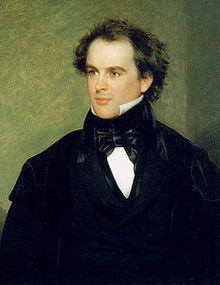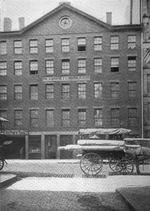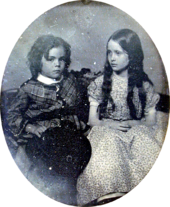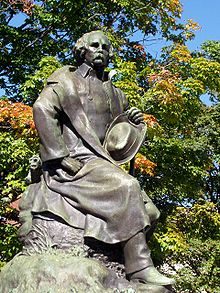- Nathaniel Hawthorne
-
Nathaniel Hawthorne 
Nathaniel Hawthorne in the 1860sBorn July 4, 1804
Salem, Massachusetts, United StatesDied May 19, 1864 (aged 59)
Plymouth, New Hampshire, United StatesNathaniel Hawthorne (born Nathaniel Hathorne; July 4, 1804 – May 19, 1864) was an American novelist and short story writer.
Nathaniel Hawthorne was born in 1804 in the city of Salem, Massachusetts to Nathaniel Hathorne and the former Elizabeth Clarke Manning. His ancestors include John Hathorne, a judge during the Salem Witch Trials. Nathaniel later added a "w" to make his name "Hawthorne". He entered Bowdoin College in 1821, was elected to Phi Beta Kappa in 1824,[1] and graduated in 1825. Hawthorne anonymously published his first work, a novel titled Fanshawe, in 1828. He published several short stories in various periodicals which he collected in 1837 as Twice-Told Tales. The next year, he became engaged to Sophia Peabody. He worked at a Custom House and joined Brook Farm, a transcendentalist community, before marrying Peabody in 1842. The couple moved to The Old Manse in Concord, Massachusetts, later moving to Salem, the Berkshires, then to The Wayside in Concord. The Scarlet Letter was published in 1850, followed by a succession of other novels. A political appointment took Hawthorne and family to Europe before their return to The Wayside in 1860. Hawthorne died on May 19, 1864, leaving behind his wife and their three children.
Much of Hawthorne's writing centers on New England, many works featuring moral allegories with a Puritan inspiration. His fiction works are considered part of the Romantic movement and, more specifically, dark romanticism. His themes often center on the inherent evil and sin of humanity, and his works often have moral messages and deep psychological complexity. His published works include novels, short stories, and a biography of his friend Franklin Pierce.
Contents
Biography
Early life
Nathaniel Hathorne was born on July 4, 1804, in Salem, Massachusetts; his birthplace is preserved and open to the public.[2] William Hathorne, the author's great-great-great-grandfather, a Puritan, was the first of the family to emigrate from England, first settling in Dorchester, Massachusetts before moving to Salem. There he became an important member of the Massachusetts Bay Colony and held many political positions including magistrate and judge, becoming infamous for his harsh sentencing.[3] William's son and the author's great-great-grandfather, John Hathorne, was one of the judges who oversaw the Salem Witch Trials. Having learned about this, the author may have added the "w" to his surname in his early twenties, shortly after graduating from college, in an effort to dissociate himself from his notorious forebears.[4] Hawthorne's father, Nathaniel Hathorne, Sr., was a sea captain who died in 1808 of yellow fever in Suriname.[5] After his death, young Nathaniel, his mother and two sisters moved in with maternal relatives, the Mannings, in Salem,[6] where they lived for 10 years. During this time, on November 10, 1813, young Hawthorne was hit on the leg while playing "bat and ball"[7] and became lame and bedridden for a year, though several physicians could find nothing wrong with him.[8]
In the summer of 1816, the family lived as boarders with farmers[9] before moving to a home recently built specifically for them by Hawthorne's uncles Richard and Robert Manning in Raymond, Maine, near Sebago Lake.[10] Years later, Hawthorne looked back at his time in Maine fondly: "Those were delightful days, for that part of the country was wild then, with only scattered clearings, and nine tenths of it primeval woods".[11] In 1819, he was sent back to Salem for school and soon complained of homesickness and being too far from his mother and sisters.[12] In spite of his homesickness, for fun, he distributed to his family seven issues of The Spectator in August and September 1820. The homemade newspaper was written by hand and included essays, poems, and news utilizing the young author's developing adolescent humor.[13]
Hawthorne's uncle Robert Manning insisted, despite Hawthorne's protests, that the boy attend college.[14] With the financial support of his uncle, Hawthorne was sent to Bowdoin College in 1821, partly because of family connections in the area, and also because of its relatively inexpensive tuition rate.[15] On the way to Bowdoin, at the stage stop in Portland, Hawthorne met future president Franklin Pierce and the two became fast friends.[14] Once at the school, he also met the future poet Henry Wadsworth Longfellow, future congressman Jonathan Cilley, and future naval reformer Horatio Bridge.[16] Years after his graduation with the class of 1825, he would describe his college experience to Richard Henry Stoddard:
I was educated (as the phrase is) at Bowdoin College. I was an idle student, negligent of college rules and the Procrustean details of academic life, rather choosing to nurse my own fancies than to dig into Greek roots and be numbered among the learned Thebans.[17]
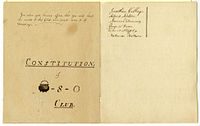 Constitution of the [Pot]-8-0 Club, secret society formed by Hawthorne and friends at Bowdoin College. Signed by Hawthorne, Jonathan Cilley and others
Constitution of the [Pot]-8-0 Club, secret society formed by Hawthorne and friends at Bowdoin College. Signed by Hawthorne, Jonathan Cilley and others
Early career
In 1836 Hawthorne served as the editor of the American Magazine of Useful and Entertaining Knowledge. During this time he boarded with the poet Thomas Green Fessenden on Hancock Street in Beacon Hill in Boston.[19] He was offered an appointment as weighter and gauger at the Boston Custom House at a salary of $1,500 a year, which he accepted on January 17, 1839.[20] During his time there, he rented a room from George Stillman Hillard, business partner of Charles Sumner.[21] Hawthorne wrote in the comparative obscurity of what he called his "owl's nest" in the family home. As he looked back on this period of his life, he wrote: "I have not lived, but only dreamed about living".[22] He contributed short stories, including "Young Goodman Brown" and "The Minister's Black Veil", to various magazines and annuals, though none drew major attention to the author. Horatio Bridge offered to cover the risk of collecting these stories in the spring of 1837 into one volume, Twice-Told Tales, which made Hawthorne known locally.[23]
Marriage and family
While at Bowdoin, Hawthorne bet his friend Jonathan Cilley a bottle of Madeira wine that Cilley would get married before him.[24] By 1836 he had won the wager, but did not remain a bachelor for life. After public flirtations with local women Mary Silsbee and Elizabeth Peabody,[25] he began pursuing the latter's sister, illustrator and transcendentalist Sophia Peabody. Seeking a possible home for himself and Sophia, he joined the transcendentalist Utopian community at Brook Farm in 1841 not because he agreed with the experiment but because it helped him save money to marry Sophia.[26] He paid a $1,000 deposit and was put in charge of shoveling the hill of manure referred to as "the Gold Mine".[27] He left later that year, though his Brook Farm adventure would prove an inspiration for his novel The Blithedale Romance.[28] Hawthorne married Sophia Peabody on July 9, 1842, at a ceremony in the Peabody parlor on West Street in Boston.[29] The couple moved to The Old Manse in Concord, Massachusetts,[30] where they lived for three years. His neighbor, Ralph Waldo Emerson, invited him into his social circle, but Hawthorne was almost pathologically shy and stayed silent when at gatherings.[31] At the Old Manse, Hawthorne wrote most of the tales collected in Mosses from an Old Manse.[32]
Like Hawthorne, Sophia was a reclusive person. Throughout her early life, she had frequent migraines and underwent several experimental medical treatments.[33] She was mostly bedridden until her sister introduced her to Hawthorne, after which her headaches seem to have abated. The Hawthornes enjoyed a long marriage, often taking walks in the park. Of his wife, whom he referred to as his "Dove", Hawthorne wrote that she "is, in the strictest sense, my sole companion; and I need no other—there is no vacancy in my mind, any more than in my heart... Thank God that I suffice for her boundless heart!"[34] Sophia greatly admired her husband's work. In one of her journals, she wrote: "I am always so dazzled and bewildered with the richness, the depth, the ... jewels of beauty in his productions that I am always looking forward to a second reading where I can ponder and muse and fully take in the miraculous wealth of thoughts".[35]
On the first anniversary of the Hawthornes' marriage, the poet Ellery Channing came to the Old Manse for help. A local teenager named Martha Hunt had drowned herself in the river and Hawthorne's boat, Pond Lily, was needed to find her body. Hawthorne helped recover the corpse, which he described as "a spectacle of such perfect horror... She was the very image of death-agony."[36] The incident later inspired a scene in his novel The Blithedale Romance.
Nathaniel and Sophia Hawthorne had three children. Their first, a daughter, was born March 3, 1844. She was named Una, a reference to The Faerie Queene, to the displeasure of family members.[37] Hawthorne wrote to a friend, "I find it a very sober and serious kind of happiness that springs from the birth of a child... There is no escaping it any longer. I have business on earth now, and must look about me for the means of doing it."[38] In 1846, their son Julian was born. Hawthorne wrote to his sister Louisa on June 22, 1846, with the news: "A small troglodyte made his appearance here at ten minutes to six o'clock this morning, who claimed to be your nephew".[39] Their final child, Rose, was born in May 1851. Hawthorne called her "my autumnal flower".[40]
Middle years
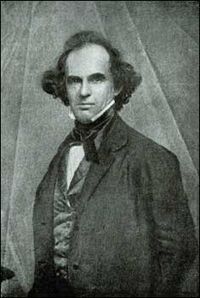 Daguerrotype of Hawthorne, Whipple & Black, 1848
Daguerrotype of Hawthorne, Whipple & Black, 1848
In April 1846, Hawthorne was officially appointed as the "Surveyor for the District of Salem and Beverly and Inspector of the Revenue for the Port of Salem" at an annual salary of $1,200.[41] He had difficulty writing during this period, as he admitted to Longfellow: "I am trying to resume my pen... Whenever I sit alone, or walk alone, I find myself dreaming about stories, as of old; but these forenoons in the Custom House undo all that the afternoons and evenings have done. I should be happier if I could write".[42] Like his earlier appointment to the custom house in Boston, this employment was vulnerable to the politics of the spoils system. A Democrat, Hawthorne lost this job due to the change of administration in Washington after the presidential election of 1848. Hawthorne wrote a letter of protest to the Boston Daily Advertiser which was attacked by the Whigs and supported by the Democrats, making Hawthorne's dismissal a much-talked about event in New England.[43] Hawthorne was deeply affected by the death of his mother shortly thereafter in late July, calling it, "the darkest hour I ever lived".[44] Hawthorne was appointed the corresponding secretary of the Salem Lyceum in 1848. Guests that came to speak that season included Emerson, Thoreau, Louis Agassiz and Theodore Parker.[45]
Hawthorne returned to writing and published The Scarlet Letter in mid-March 1850,[46] including a preface which refers to his three-year tenure in the Custom House and makes several allusions to local politicians, who did not appreciate their treatment.[47] One of the first mass-produced books in America, it sold 2,500 volumes within ten days and earned Hawthorne $1,500 over 14 years.[48] The book was immediately pirated by booksellers in London[citation needed] and became an immediate best-seller in the United States;[49] it initiated his most lucrative period as a writer.[48] One of Hawthorne's friends, the critic Edwin Percy Whipple, objected to the novel's "morbid intensity" and its dense psychological details, writing that the book "is therefore apt to become, like Hawthorne, too painfully anatomical in his exhibition of them",[50] though 20th century writer D. H. Lawrence said that there could be no more perfect work of the American imagination than The Scarlet Letter.[51]
Hawthorne and his family moved to a small red farmhouse near Lenox, Massachusetts at the end of March 1850.[52] Hawthorne became friends with Oliver Wendell Holmes, Sr. and Herman Melville beginning on August 5, 1850, when the authors met at a picnic hosted by a mutual friend.[53] Melville had just read Hawthorne's short story collection Mosses from an Old Manse, and his unsigned review of the collection, titled "Hawthorne and His Mosses", was printed in The Literary World on August 17 and August 24.[54] Melville, who was composing Moby-Dick at the time, wrote that these stories revealed a dark side to Hawthorne, "shrouded in blackness, ten times black".[55] Melville dedicated Moby-Dick (1851) to Hawthorne: "In token of my admiration for his genius, this book is inscribed to Nathaniel Hawthorne."[56]
Hawthorne's time in The Berkshires was very productive.[57] The House of the Seven Gables (1851), which poet and critic James Russell Lowell said was better than The Scarlet Letter and called "the most valuable contribution to New England history that has been made"[58] and The Blithedale Romance (1852), his only work written in the first person,[28] were written here. He also published in 1851 a collection of short stories retelling myths, A Wonder-Book for Girls and Boys, a book he had been thinking about writing since 1846.[59] Nevertheless, the poet Ellery Channing reported that Hawthorne "has suffered much living in this place".[60] Though the family enjoyed the scenery of The Berkshires, Hawthorne did not enjoy the winters in their small red house. They left on November 21, 1851.[57] Hawthorne noted, "I am sick to death of Berkshire... I have felt languid and dispirited, during almost my whole residence."[61]
The Wayside and Europe
In 1852, the Hawthornes returned to Concord. In February, they bought The Hillside, a home previously inhabited by Amos Bronson Alcott and his family, and renamed it The Wayside.[62] Their neighbors in Concord included Emerson and Henry David Thoreau.[63] That year Hawthorne wrote the campaign biography of his friend Franklin Pierce, depicting him as "a man of peaceful pursuits" in the book, which he titled The Life of Franklin Pierce.[64] Horace Mann said, "If he makes out Pierce to be a great man or a brave man, it will be the greatest work of fiction he ever wrote".[64] In the biography, Hawthorne depicted Pierce as a statesman and soldier who had accomplished no great feats because of his need to make "little noise" and so "withdrew into the background".[65] He also left out Pierce's drinking habits despite rumors of his alcoholism[66] and emphasized Pierce's belief that slavery could not "be remedied by human contrivances" but would, over time, "vanish like a dream".[67] With Pierce's election as President, Hawthorne was rewarded in 1853 with the position of United States consul in Liverpool shortly after the publication of Tanglewood Tales.[68] The role, considered the most lucrative foreign service position at the time, was described by Hawthorne's wife as "second in dignity to the Embassy in London".[69] In 1857, his appointment ended at the close of the Pierce administration and the Hawthorne family toured France and Italy. During his time in Italy, the previously clean-shaven Hawthorne grew a bushy mustache.[70]
The family returned to The Wayside in 1860,[71] and that year saw the publication of The Marble Faun, his first new book in seven years.[72] Hawthorne admitted he had aged considerably, referring to himself as "wrinkled with time and trouble".[73]
Later years and death
At the outset of the American Civil War, Hawthorne traveled with William D. Ticknor to Washington, D.C.. There, he met Abraham Lincoln and other notable figures. He wrote about his experiences in the essay "Chiefly About War Matters" in 1862.
Failing health prevented him from completing several more romances. Suffering from pain in his stomach, Hawthorne insisted on a recuperative trip with his friend Franklin Pierce, though his neighbor Bronson Alcott was concerned Hawthorne was too ill.[74] While on a tour of the White Mountains, Hawthorne died in his sleep on May 19, 1864, in Plymouth, New Hampshire. Pierce sent a telegram to Elizabeth Peabody to inform Hawthorne's wife in person; she was too saddened by the news to handle the funeral arrangements herself.[75] Hawthorne's son Julian, at the time a freshman at Harvard College, learned of his father's death the next day; coincidentally, it was the same day he was initiated into the Delta Kappa Epsilon fraternity by being placed blindfolded into a coffin.[76] Longfellow wrote a tribute poem to Hawthorne, published in 1866, called "The Bells of Lynn".[77] Hawthorne was buried on what is now known as "Authors' Ridge" in Sleepy Hollow Cemetery, Concord, Massachusetts. Pallbearers included Longfellow, Emerson, Holmes, Alcott, James Thomas Fields, and Edwin Percy Whipple.[78] Emerson wrote of the funeral: "I thought there was a tragic element in the event, that might be more fully rendered,—in the painful solitude of the man, which, I suppose, could no longer be endured, & he died of it."[79]
After their respective deaths, wife Sophia and daughter Una were originally buried in England. However, in June 2006, they were re-interred in plots adjacent to Hawthorne.[80]
Writings
Hawthorne had a particularly close relationship with his publishers William Ticknor and James Thomas Fields.[81] Hawthorne once told Fields, "I care more for your good opinion than for that of a host of critics".[82] In fact, it was Fields who convinced Hawthorne to turn The Scarlet Letter into a novel rather than a short story.[83] Ticknor handled many of Hawthorne's personal matters, including the purchase of cigars, overseeing financial accounts, and even purchasing clothes.[84] Ticknor died with Hawthorne at his side in Philadelphia in 1864; Hawthorne was left, according to a friend, "apparently dazed".[85]
Literary style and themes
Hawthorne's works belong to romanticism or, more specifically, dark romanticism,[86] cautionary tales that suggest that guilt, sin, and evil are the most inherent natural qualities of humanity.[87] Many of his works are inspired by Puritan New England,[88] combining historical romance loaded with symbolism and deep psychological themes, bordering on surrealism.[89] His depictions of the past are a version of historical fiction used only as a vehicle to express common themes of ancestral sin, guilt and retribution.[90] His later writings also reflect his negative view of the Transcendentalism movement.[91]
Hawthorne was predominantly a short story writer in his early career. Upon publishing Twice-Told Tales, however, he noted, "I do not think much of them", and he expected little response from the public.[92] His four major romances were written between 1850 and 1860: The Scarlet Letter (1850), The House of the Seven Gables (1851), The Blithedale Romance (1852) and The Marble Faun (1860). Another novel-length romance, Fanshawe was published anonymously in 1828. Hawthorne defined a romance as being radically different from a novel by not being concerned with the possible or probable course of ordinary experience.[93] In the preface to The House of the Seven Gables, Hawthorne describes his romance-writing as using "atmospherical medium as to bring out or mellow the lights and deepen and enrich the shadows of the picture."[94]
Hawthorne also wrote nonfiction. In 2008, The Library of America selected Hawthorne's "A Collection of Wax Figures" for inclusion in its two-century retrospective of American True Crime.
Criticism
Edgar Allan Poe wrote important and somewhat unflattering reviews of both Twice-Told Tales and Mosses from an Old Manse. Poe's negative assessment was partly due to his own contempt of allegory and moral tales, and his chronic accusations of plagiarism, though he admitted, "The style of Hawthorne is purity itself. His tone is singularly effective—wild, plaintive, thoughtful, and in full accordance with his themes... We look upon him as one of the few men of indisputable genius to whom our country has as yet given birth".[95] Ralph Waldo Emerson wrote that "Nathaniel Hawthorne's reputation as a writer is a very pleasing fact, because his writing is not good for anything, and this is a tribute to the man".[96] Henry James praised Hawthorne, saying, "The fine thing in Hawthorne is that he cared for the deeper psychology, and that, in his way, he tried to become familiar with it".[97] Poet John Greenleaf Whittier wrote that he admired the "weird and subtle beauty" in Hawthorne's tales.[98] Evert Augustus Duyckinck said of Hawthorne, "Of the American writers destined to live, he is the most original, the one least indebted to foreign models or literary precedents of any kind".[99]
Contemporary response to Hawthorne's work praised his sentimentality and moral purity while more modern evaluations focus on the dark psychological complexity.[100] Beginning in the 1950s, critics have focused on symbolism and didacticism.[101]
The critic Harold Bloom has opined that only Henry James and William Faulkner challenge Hawthorne's position as the greatest American novelist, although he admits that he favours James as the greatest American novelist.[102][103] Bloom sees Hawthorne's greatest works to be principally The Scarlet Letter followed by The Marble Faun and certain of his short stories including My Kinsman, Major Molineux, Young Goodman Browne, Wakefield and Feathertop.[103]
Selected works
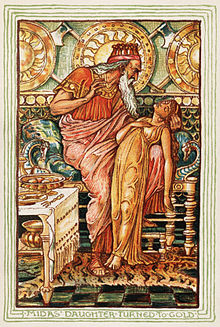 The Midas myth, from A Wonder-Book for Girls and Boys. Illustration by Walter Crane for the 1893 edition.
The Midas myth, from A Wonder-Book for Girls and Boys. Illustration by Walter Crane for the 1893 edition.
Novels
- Fanshawe (published anonymously, 1828)[104]
- The Scarlet Letter (1850)
- The House of the Seven Gables (1851)
- The Blithedale Romance (1852)
- The Marble Faun: Or, The Romance of Monte Beni (1860) (as Transformation: Or, The Romance of Monte Beni, UK publication, same year)
- The Dolliver Romance (1863) (unfinished)
- Septimius Felton; or, the Elixir of Life (Published in the Atlantic Monthly, 1872)
- Doctor Grimshawe's Secret: A romance (unfinished), with Preface and Notes by Julian Hawthorne (1882)
Short story collections
- Twice-Told Tales (1837)
- Grandfather's Chair (1840)
- Mosses from an Old Manse (1846)
- The Snow-Image, and Other Twice-Told Tales (1852)
- A Wonder-Book for Girls and Boys (1852)
- Tanglewood Tales (1853)
- The Dolliver Romance and Other Pieces (1876)
- The Great Stone Face and Other Tales of the White Mountains (1889)
- The Celestial Railroad and Other Short Stories
Selected short stories
- "Roger Malvin's Burial" (1832)
- "My Kinsman, Major Molineux" (1832)
- "Young Goodman Brown" (1835)
- "The Gray Champion" (1835)
- "The White Old Maid" (1835)
- "Wakefield" (1835)
- "The Ambitious Guest" (1835)
- "The Minister's Black Veil" (1836)
- "The Man of Adamant" (1837)
- "The Maypole of Merry Mount" (1837)
- "The Great Carbuncle" (1837)
- "Dr. Heidegger's Experiment" (1837)
- "A Virtuoso's Collection" (May 1842)
- "The Birth-Mark" (March 1843)
- "Egotism; or, The Bosom-Serpent" (1843)
- "The Artist of the Beautiful" (1844)
- "Rappaccini's Daughter" (1844)
- "P.'s Correspondence" (1845)
- "Ethan Brand" (1850)
- "Feathertop" (1852)
Notes
- ^ Who Belongs To Phi Beta Kappa, ’Phi Beta Kappa website’’, accessed Oct 4, 2009
- ^ Haas, Irvin. Historic Homes of American Authors. Washington, DC: The Preservation Press, 1991: 118. ISBN 0-89133-180-8.
- ^ Miller, 20–21
- ^ McFarland, 18
- ^ Wineapple, 20–21
- ^ McFarland, 17
- ^ Miller, 47
- ^ Mellow, 18
- ^ Mellow, 20
- ^ Miller, 50
- ^ Mellow, 21
- ^ Mellow, 22
- ^ Miller, 57
- ^ a b Edwards, Herbert. "Nathaniel Hawthorne in Maine", 'Downeast Magazine', 1962
- ^ Wineapple, 44–45
- ^ Cheever, 99
- ^ Miller, 76
- ^ George Edwin Jepson. Hawthorne in the Boston Custom House. The Bookman. Aug. 1904.
- ^ Wineapple, 87–88
- ^ Miller, 169
- ^ Mellow, 169
- ^ Letter to Longfellow, June 4, 1837.
- ^ McFarland, 22–23
- ^ Manning Hawthorne, "Nathaniel Hawthorne at Bowdoin", The New England Quarterly, Vol. 13, No. 2 (Jun., 1940): 246–279.
- ^ Cheever, 102
- ^ McFarland, 83
- ^ Cheever, 104
- ^ a b McFarland, 149
- ^ Wineapple, 160
- ^ McFarland, 25
- ^ Schreiner, 123
- ^ Miller, 246–247
- ^ Mellow, 6–7
- ^ McFarland, 87
- ^ January 14, 1851, Journal of Sophia Hawthorne. Berg Collection NY Public Library.
- ^ Schreiner, 116–117
- ^ McFarland, 97
- ^ Schreiner, 119
- ^ Mellow, 273
- ^ Miller, 343–344
- ^ Miller, 242
- ^ Miller, 265
- ^ Cheever, 179
- ^ Cheever, 180
- ^ Miller, 264–265
- ^ Miller, 300
- ^ Mellow, 316
- ^ a b McFarland, 136
- ^ Cheever, 181
- ^ Miller, 301–302
- ^ Miller, 284
- ^ Miller, 274
- ^ Cheever, 174
- ^ Miller, 312
- ^ Mellow, 335
- ^ Mellow, 382
- ^ a b Wright, John Hardy. Hawthorne's Haunts in New England. Charleston, SC: The History Press, 2008: 93. ISBN 978-1-59629-425-7
- ^ Mellow, 368–369
- ^ Miller, 345
- ^ Wineapple, 241
- ^ Wineapple, 242
- ^ McFarland, 129–130
- ^ McFarland, 182
- ^ a b Miller, 381
- ^ Schreiner, 170–171
- ^ Mellow, 412
- ^ Miller, 382–383
- ^ McFarland, 186
- ^ Mellow, 415
- ^ McFarland, 210
- ^ McFarland, 206
- ^ Mellow, 520
- ^ Schreiner, 207
- ^ Wineapple, 372
- ^ Miller, 518
- ^ Matthews, Jack (August 15, 2010). "Nathaniel Hawthorne's Untold Tale". The Chronicle Review. http://chronicle.com/article/Nathaniel-Hawthornes-Untold/123889. Retrieved 2010-08-17.
- ^ Wagenknecht, Edward. Henry Wadsworth Longfellow: Portrait of an American Humanist. New York: Oxford University Press, 1966: 9.
- ^ Baker, Carlos. Emerson Among the Eccentrics: A Group Portrait. New York: Viking Press, 1996: 448. ISBN 0-670-86675-X.
- ^ McFarland, 297
- ^ Mishra, Raja and Sally Heaney. "Hawthornes to be reunited", The Boston Globe. June 1, 2006. Accessed July 4, 2008
- ^ Madison, 9
- ^ Miller, 281
- ^ Charvat, William. Literary Publishing in America: 1790–1850. Amherst, MA: The University of Massachusetts Press, 1993 (first published 1959): 56. ISBN 0-87023-801-9
- ^ Madison, 15
- ^ Miller, 513–514
- ^ Reynolds, David S. Beneath the American Renaissance: The Subversive Imagination in the Age of Emerson and Melville. Cambridge, Massachusetts: Harvard University Press, 1988: 524. ISBN 0-674-06565-4
- ^ Wayne, Tiffany K. "Nathaniel Hawthorne", Encyclopedia of Transcendentalism. New York: Facts on File, Inc., 2006: 140. ISBN 0-8160-5626-9.
- ^ Bell, Michael Davitt. Hawthorne and the Historical Romance of New England. Boston: Houghton Mifflin Company, 1980: 173. ISBN 0-691-06136-X
- ^ Howe, Daniel Walker. What Hath God Wrought: The Transformation of America, 1815–1848. New York: Oxford University Press, 2007: 633. ISBN 978-0-19-507894-7.
- ^ Crews, 28–29
- ^ Galens, David, ed. Literary Movements for Students, Vol. 1. Detroit: Thompson Gale, 2002: 319. ISBN 0-7876-6517-7
- ^ Miller, 104
- ^ Porte, 95
- ^ Wineapple, 237
- ^ McFarland, 88–89
- ^ Nelson, Randy F. (editor). The Almanac of American Letters. Los Altos, California: William Kaufmann, Inc., 1981: 150. ISBN 0-86576-008-X.
- ^ Porte, 97
- ^ Woodwell, Roland H. John Greenleaf Whittier: A Biography. Haverhill, Massachusetts: Trustees of the John Greenleaf Whittier Homestead, 1985: 293.
- ^ McFarland, 88
- ^ Person, Leland S. "Bibliographical Essay: Hawthorne and History", collected in A Historical Guide to Nathaniel Hawthorne. Oxford University Press, 2001: 187. ISBN 0-19-512414-6.
- ^ Crews, 4
- ^ Nathaniel Hawthorne By Harold Bloom (2000) p9
- ^ a b Nathaniel Hawthorne By Harold Bloom xii
- ^ Publication info on books from Editor's Note to The Scarlet Letter by Nathaniel Hawthorne, Page by Page Books, accessed June 11, 2007.
- Sources
- Cheever, Susan. American Bloomsbury: Louisa May Alcott, Ralph Waldo Emerson, Margaret Fuller, Nathaniel Hawthorne, and Henry David Thoreau; Their Lives, Their Loves, Their Work. Detroit: Thorndike Press, 2006. Large print edition. ISBN 0-7862-9521-X.
- Crews, Frederick. The Sins of the Fathers: Hawthorne's Psychological Themes. Berkeley: University of California Press, 1966; reprinted 1989. ISBN 0-520-06817-3.
- Madison, Charles A. Irving to Irving: Author-Publisher Relations 1800–1974. New York: R. R. Bowker Company, 1974.
- McFarland, Philip. Hawthorne in Concord. New York: Grove Press, 2004. ISBN 0-8021-1776-7.
- Mellow, James R. Nathaniel Hawthorne in His Times. Boston: Houghton Mifflin Company, 1980. ISBN 0-365-27602-0.
- Miller, Edwin Haviland. Salem Is My Dwelling Place: A Life of Nathaniel Hawthorne. Iowa City: University of Iowa Press, 1991. ISBN 0-87745-332-2.
- Porte, Joel. The Romance in America: Studies in Cooper, Poe, Hawthorne, Melville, and James. Middletown, Conn.: Wesleyan University Press, 1969.
- Schreiner, Samuel A., Jr. The Concord Quartet: Alcott, Emerson, Hawthorne, Thoreau, and the Friendship that Freed the American Mind. Hoboken, NJ: John Wiley and Sons, 2006. ISBN 0-471-64663-6.
- Wineapple, Brenda. Hawthorne: A Life. Random House: New York, 2003. ISBN 0-8129-7291-0.
See also
- Gothic literature
External links
- About Hawthorne
- The Hawthorne in Salem website
- Herman Melville's appreciation, "Hawthorne and His Mosses" (1851)
- Henry James's book-length study, Hawthorne (1879)
- WBUR's celebration of Nathaniel Hawthorne at 200
- Hawthorne Family Papers, ca. 1825–1929, housed in the Department of Special Collections at Stanford University Libraries
- Related websites
- Hawthorne Community Association and boyhood home in Raymond, Maine
- The Wayside in Concord, Massachusetts
- The House of the Seven Gables in Salem, Massachusetts
- The Phillips Library of The Peabody Essex Museum in Salem, Massachusetts owns several well-known Hawthorne related manuscript collections.
- Works
- Eldred's Hawthorne site at Eldritch Press
- Legends of the Province House and Other Twice Told Tales, text and images
- Works by Nathaniel Hawthorne at Project Gutenberg
- Works by or about Nathaniel Hawthorne in libraries (WorldCat catalog)
Nathaniel Hawthorne Novels The Blithedale Romance · Doctor Grimshaw's Secret · The Dolliver Romance · Fanshawe · The House of the Seven Gables · The Marble Faun · The Scarlet LetterTwice-Told Tales "The Gray Champion" · "Sundays at Home" · "The Wedding-Knell" · "The Minister's Black Veil" · "The May-Pole of Merry Mount" · "The Gentle Boy" · "Mr. Higginbotham's Catastrophe" · "Little Annie's Ramble" · "Wakefield" · "A Rill from the Town-Pump" · "The Great Carbuncle" · "The Prophetic Pictures" · "David Swan" · "Sights from a Steeple" · "The Hollow of the Three Hills" · "The Toll-Gatherer's Day" · "The Vision of the Fountain" · "Fancy's Show Box" · "Dr. Heidegger's Experiment" · "Legends of the Province-House" · "The Haunted Mind" · "The Village Uncle" · "The Ambitious Guest" · "The Sister Years" · "Snow-Flakes" · "The Seven Vagabonds" · "The White Old Maid" · "Peter Goldthwaite's Treasure" · "Chippings with a Chisel" · "The Shaker Bridal" · "Night Sketches" · "Endicott and the Red Cross" · "The Lily's Quest" · "Foot-prints on the Sea-shore" · "Edward Fane's Rosebud" · "The Threefold Destiny"The Snow-Image, and
Other Twice-Told Tales"The Snow-Image" · "The Great Stone Face" · "Main-street" · "Ethan Brand" · "A Bell's Biography" · "Sylph Etherege" · "The Canterbury Pilgrims" · "Old News" · "The Man of Adamant" · "The Devil in Manuscript" · "John Inglefield's Thanksgiving" · "Old Ticonderoga" · "The Wives of the Dead" · "Little Daffydowndilly" · "My Kinsman, Major Molineux"Mosses from an Old Manse "The Old Manse" · "The Birth-Mark" · "A Select Party" · "Young Goodman Brown" · "Rappaccini's Daughter" · "Mrs. Bullfrog" · "Fire-Worship" · "Buds and Bird-Voices" · "Monsieur du Miroir" · "The Hall of Fantasy" · "The Celestial Rail-road" · "The Procession of Life" · "Feathertop" · "The New Adam and Eve" · "Egotism; or, The Bosom-Serpent" · "The Christmas Banquet" · "Drowne's Wooden Image" · "The Intelligence Office" · "Roger Malvin's Burial" · "P.'s Correspondence" · "Earth's Holocaust" · "Passages from a Relinquished Work" · "Sketches from Memory" · "The Old Apple-Dealer" · "The Artist of the Beautiful" · "A Virtuoso's Collection"Categories:- Nathaniel Hawthorne
- American novelists
- American short story writers
- Writers from Massachusetts
- United States consuls in Liverpool
- Bowdoin College alumni
- Massachusetts Democrats
- 1804 births
- 1864 deaths
- American people of English descent
- People from Salem, Massachusetts
- People from Concord, Massachusetts
Wikimedia Foundation. 2010.

